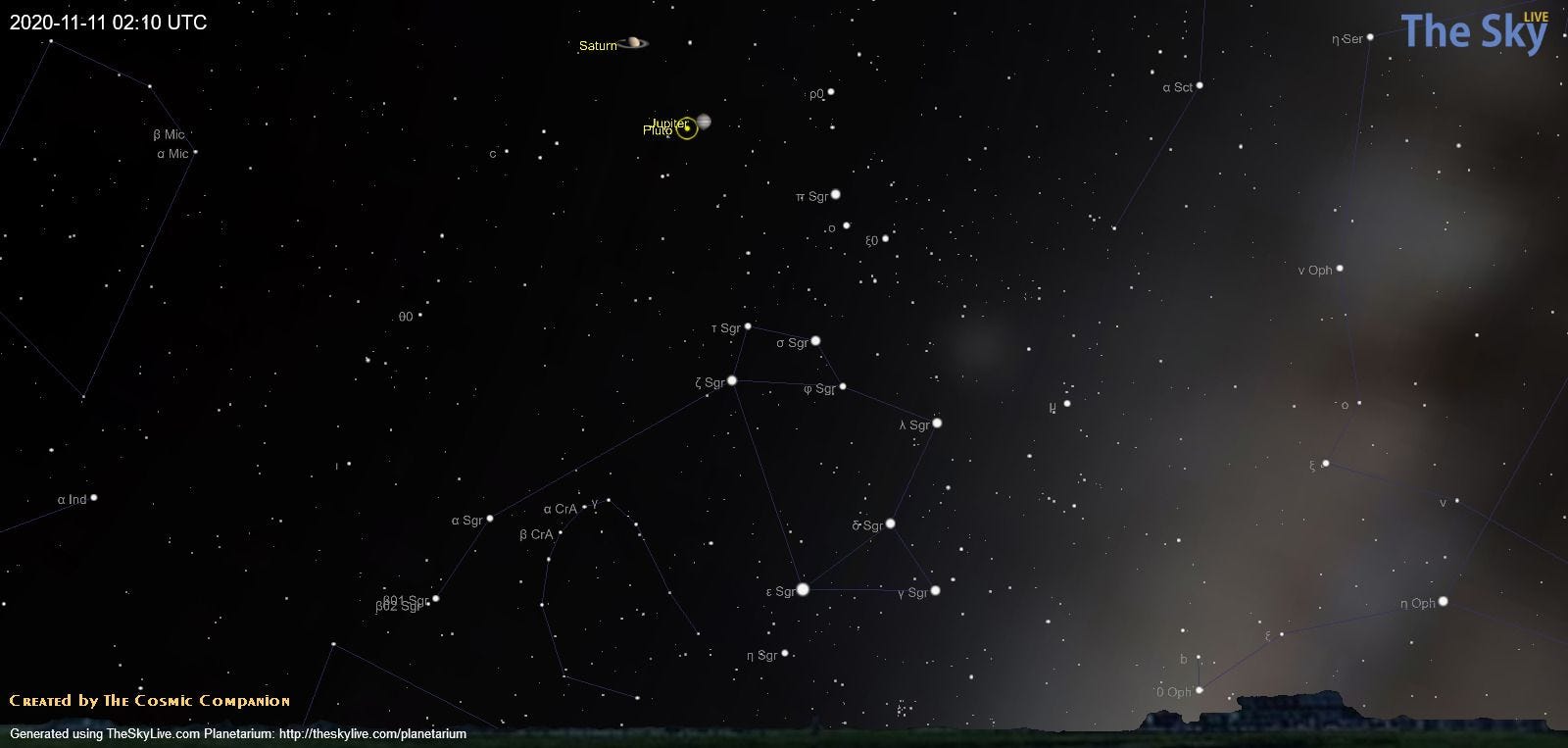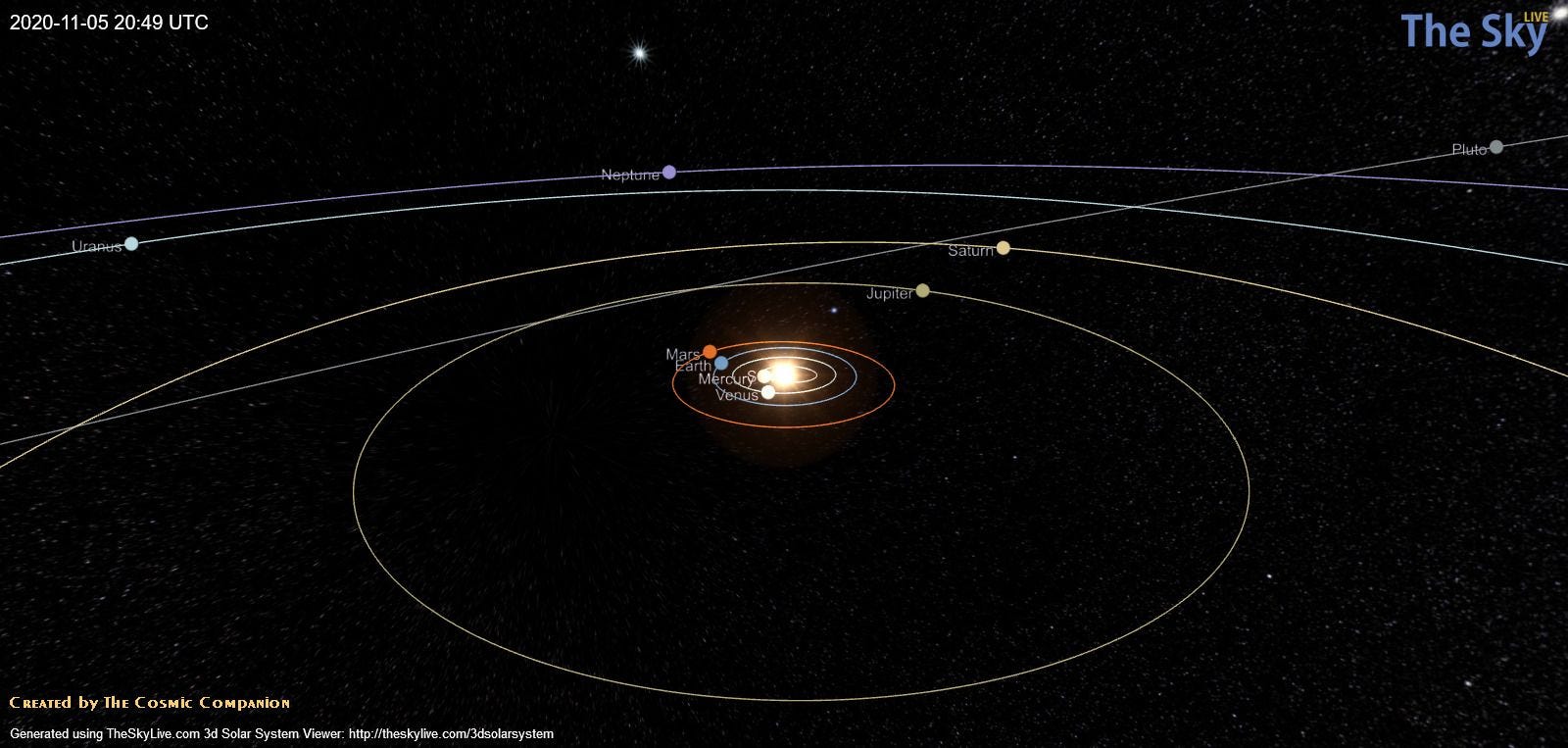Every planet in our Solar System will be visible this week — here’s how to spot them, Κάθε πλανήτης στο Ηλιακό μας Σύστημα θα είναι ορατός αυτήν την εβδομάδα - εδώ μπορείτε να τους εντοπίσετε
ακολουθεί ελληνικό κείμενο μετάφραση στο τέλος - -All the planets in the Solar System are visible in the night sky this week, making a beautiful sight for stargazers. Even the outermost planets — Uranus, and Neptune (plus the dwarf planet Pluto) can be seen by observers using telescopes.
Jupiter and Saturn can easily be found in the southwestern region of the evening skies, while everyone’s favorite ex-planet, Pluto, can be found by skilled amateur astronomers. Venus and Mercury, huddling close to the Sun, can be seen just before sunrise. Mars, meanwhile, is spending its time with our two ice giants — Uranus and Neptune.
Fire and ice
The southeastern sky, a little after sunset, offers Mars — glowing brilliant red. And, the two planets discovered in the age of telescopes — Uranus and Neptune — can be found straddling the Red Planet.
Using a telescope or binoculars, Uranus can found about 13 degrees above Mars, and 20 degrees north (left) of the Red Planet. It will appear as a small, light blue disk in most telescopes or binoculars.
Neptune — dimmer, darker, and harder to find than Uranus, can be seen 11 degrees below, and 31 degrees south (right) of Mars. Finding this planet can present a real challenge for amateur astronomers.
The two heavyweight champions
The evening sky also offers Jupiter and Saturn shining brightly high above the southwestern horizon.
These two largest planets are currently just a few degrees apart from each other, and they coming together as seen from Earth. On December 21, these two worlds will be the closest they will be seen until March 2080.
Saturn is the most distant planet visible with unaided eyes. However, using binoculars or a telescope allows viewers to see that planet’s magnificent series of rings.
Amateur astronomers should find Jupiter first, shining brightly in the southwestern sky, soon after sunset. Just a few degrees away from that world is Saturn, shining less brightly, with a distinctive yellow hue.
Amateur astronomers will need dark skies and a telescope of at least 12″ diameter to find Pluto, but this lovable underdog is currently hiding in the darkness less than a degree (two full Moons) below and to the north (left) of mighty Jupiter.
For you, early birds (what’s so great about worms, anyway?)
Venus, the third-brightest object in the sky after the Sun and Moon, shines just before dawn. This world is roughly the same size, and has the same mass, as Earth. But, sulfuric acid rain, crushing pressures, and temperatures hot enough to melt lead make this a hellish world — except, perhaps, within a temperate zone found in its upper atmosphere.
This world shines exceedingly bright in the southeastern sky, and should be an easy find for anyone with a clear view to the southeast.
Mercury, 70 times dimmer than Venus, can be found below Venus, closer to the horizon. This world is usually visible to the naked eye, but binoculars or a telescope makes finding Mercury easier to find. This planet can be seen (under dark skies) sitting about 12 degrees below, and four degrees north (to the left) of Venus.
As November progresses, Mercury will grow brighter each day, and it will be seen higher above the horizon.
Although this planet is the closest to the Sun, it is — on average — cooler than Venus, due to the thick atmosphere surrounding its larger companion, creating a runaway greenhouse effect.
You just couldn’t planet this way…
“Sometimes I wonder if the planets are still up there, still aligned, still managing to get along after all this time. Maybe we could learn a thing or two from them.”― Tahereh Mafi, Ignite Me
The relatively rare alignment of all the planets happening this week offers amateur skygazers a chance to view these planetary wonders of our solar system.
One trick when searching out targets in the sky is to hold out a fist at arm’s length. This covers roughly 10 degrees, while a single finger at arm’s length is approximately two degrees from side to side.
The Moon can drown out dim objects with light, but our planetary companion will become dimmer (and rise later) each night, until November 15. Then, the Moon will grow brighter until the end of the month.
While we look up at seven of the eight planets in the night sky, let’s also take a moment to look down, and remember the only planet we know of capable of supporting life — the Earth.
This article was originally published on The Cosmic Companion by James Maynard, founder and publisher of The Cosmic Companion. He is a New England native turned desert rat in Tucson, where he lives with his lovely wife, Nicole, and Max the Cat. You can read this original piece here.
Astronomy News with The Cosmic Companion is also available as a weekly podcast, carried on all major podcast providers. Tune in every Tuesday for updates on the latest astronomy news, and interviews with astronomers and other researchers working to uncover the nature of the Universe.
------------------------------------------------------------------------------------------------------------------
Όλοι οι πλανήτες στο Ηλιακό Σύστημα είναι ορατοί στον νυχτερινό ουρανό αυτήν την εβδομάδα, κάνοντας ένα όμορφο θέαμα για τους αστέρι. Ακόμα και οι εξόχως πλανήτες - ο Ουρανός και ο Ποσειδώνας (συν ο νάνος πλανήτης Πλούτωνας) μπορούν να δουν οι παρατηρητές χρησιμοποιώντας τηλεσκόπια.
Ο Δίας και ο Κρόνος μπορούν εύκολα να βρεθούν στη νοτιοδυτική περιοχή του βραδινού ουρανού, ενώ ο αγαπημένος πρώην πλανήτης, ο Πλούτωνας, μπορεί να βρεθεί από εξειδικευμένους ερασιτέχνες αστρονόμους. Η Αφροδίτη και ο Ερμής, που συσσωρεύονται κοντά στον Ήλιο, φαίνονται λίγο πριν από την ανατολή. Ο Άρης, εν τω μεταξύ, περνά το χρόνο του με τους δύο γίγαντες του πάγου μας - τον Ουρανό και τον Ποσειδώνα.
Η εύρεση του Άρη είναι εύκολη αυτή την εβδομάδα - και ο Κόκκινος Πλανήτης μπορεί να χρησιμοποιηθεί για να βρει δύο πιο απαιτητικούς στόχους για ερασιτέχνες αστρονόμους - τον Ουρανό και τον Ποσειδώνα. Πιστωτική εικόνα: Δημιουργήθηκε από το Cosmic Companion / Δημιουργήθηκε στο The Sky Live.
Ο νοτιοανατολικός ουρανός, λίγο μετά το ηλιοβασίλεμα, προσφέρει στον Άρη - λαμπερό κόκκινο. Και, οι δύο πλανήτες που ανακαλύφθηκαν στην εποχή των τηλεσκοπίων - Ουρανός και Ποσειδώνας - μπορούν να βρεθούν να περιβάλλουν τον Κόκκινο Πλανήτη.
Χρησιμοποιώντας ένα τηλεσκόπιο ή κιάλια, ο Ουρανός μπορεί να βρει περίπου 13 μοίρες πάνω από τον Άρη και 20 μοίρες βόρεια (αριστερά) του κόκκινου πλανήτη. Θα εμφανίζεται ως ένας μικρός, γαλάζιος δίσκος στα περισσότερα τηλεσκόπια ή κιάλια.
Ο Ποσειδώνας - πιο σκοτεινός, πιο σκοτεινός και πιο δύσκολος να βρεθεί από τον Ουρανό, μπορεί να δει 11 βαθμούς κάτω και 31 μοίρες νότια (δεξιά) του Άρη. Η εύρεση αυτού του πλανήτη μπορεί να αποτελέσει πραγματική πρόκληση για τους ερασιτέχνες αστρονόμους.
Ο Δίας και ο Κρόνος, μεταξύ των πιο φωτεινών αντικειμένων στο Ηλιακό Σύστημα, είναι ευρήματα στον δυτικό ουρανό αυτή την εβδομάδα. Και, ο πρώην πλανήτης Πλούτωνας μπορεί επίσης να δει κοντά στον Δία, χρησιμοποιώντας ένα μεγαλύτερο τηλεσκόπιο. Πιστωτική εικόνα: Δημιουργήθηκε από το Cosmic Companion / Δημιουργήθηκε στο The Sky Live.
Ο βραδινός ουρανός προσφέρει επίσης τον Δία και τον Κρόνο να λάμπει έντονα ψηλά πάνω από τον νοτιοδυτικό ορίζοντα.
Αυτοί οι δύο μεγαλύτεροι πλανήτες απέχουν μόλις λίγους βαθμούς ο ένας από τον άλλο και συναντώνται όπως φαίνεται από τη Γη. Στις 21 Δεκεμβρίου, αυτοί οι δύο κόσμοι θα είναι οι πιο κοντινοί που θα φανούν μέχρι τον Μάρτιο του 2080.
Ο Κρόνος είναι ο πιο μακρινός πλανήτης ορατός με αβοήθητα μάτια. Ωστόσο, η χρήση κιάλια ή τηλεσκοπίου επιτρέπει στους θεατές να δουν την υπέροχη σειρά δαχτυλιδιών αυτού του πλανήτη.
Οι ερασιτέχνες αστρονόμοι πρέπει να βρουν πρώτα τον Δία, να λάμπει λαμπρά στον νοτιοδυτικό ουρανό, λίγο μετά το ηλιοβασίλεμα. Μόλις λίγες μοίρες μακριά από αυτόν τον κόσμο βρίσκεται ο Κρόνος, που λάμπει λιγότερο έντονα, με μια χαρακτηριστική κίτρινη απόχρωση.
Οι ερασιτέχνες αστρονόμοι θα χρειαστούν σκοτεινούς ουρανούς και ένα τηλεσκόπιο διαμέτρου τουλάχιστον 12 to για να βρουν τον Πλούτωνα, αλλά αυτό το αξιαγάπητο αουτσάιντερ κρύβεται επί του παρόντος στο σκοτάδι λιγότερο από ένα βαθμό (δύο πλήρες φεγγάρια) παρακάτω και στα βόρεια (αριστερά) του ισχυρού Δία.
Η Αφροδίτη είναι δύσκολο να χάσετε στον ουρανό πριν από την αυγή. Εάν δεν μπορείτε να το βρείτε, χρειάζεστε περισσότερο καφέ. Ο υδράργυρος είναι πιο δύσκολο να βρεθεί, αλλά εξακολουθεί να είναι μια ικανοποιητική θέα για όσους θέλουν να το αναζητήσουν. Πιστωτική εικόνα: Δημιουργήθηκε από το Cosmic Companion / Δημιουργήθηκε στο The Sky Live.
Η Αφροδίτη, το τρίτο φωτεινότερο αντικείμενο στον ουρανό μετά τον Ήλιο και τη Σελήνη, λάμπει λίγο πριν την αυγή. Αυτός ο κόσμος έχει περίπου το ίδιο μέγεθος και έχει την ίδια μάζα με τη Γη. Όμως, η βροχή με θειικό οξύ, οι συνθλιπτικές πιέσεις και οι θερμοκρασίες που είναι αρκετά ζεστές για να λιώσουν το μόλυβδο το καθιστούν έναν κοσμικό κόσμο - εκτός, ίσως, μέσα σε μια εύκρατη ζώνη που βρίσκεται στην ανώτερη ατμόσφαιρα.
Αυτός ο κόσμος λάμπει πάρα πολύ φωτεινός στον νοτιοανατολικό ουρανό και πρέπει να είναι εύκολο να βρεθεί για όποιον έχει καθαρή θέα προς τα νοτιοανατολικά.
Ο υδράργυρος, 70 φορές πιο αμυδρό από την Αφροδίτη, βρίσκεται κάτω από την Αφροδίτη, πιο κοντά στον ορίζοντα. Αυτός ο κόσμος είναι συνήθως ορατός με γυμνό μάτι, αλλά τα κιάλια ή ένα τηλεσκόπιο διευκολύνουν την εύρεση του Ερμή. Αυτός ο πλανήτης μπορεί να δει (κάτω από σκοτεινούς ουρανούς) να κάθεται περίπου 12 μοίρες κάτω και τέσσερις μοίρες βόρεια (αριστερά) της Αφροδίτης.
Καθώς προχωρά ο Νοέμβριος, ο Ερμής θα αυξάνεται κάθε μέρα και θα φαίνεται ψηλότερα από τον ορίζοντα.
Αν και αυτός ο πλανήτης είναι ο πλησιέστερος στον Ήλιο, είναι - κατά μέσο όρο - πιο δροσερός από την Αφροδίτη, λόγω της παχιάς ατμόσφαιρας που περιβάλλει τον μεγαλύτερο σύντροφό του, δημιουργώντας ένα φαινόμενο θερμοκηπίου.
«Μερικές φορές αναρωτιέμαι αν οι πλανήτες είναι ακόμα εκεί, ακόμα ευθυγραμμισμένοι, εξακολουθούν να καταφέρνουν να ακολουθήσουν μετά από όλο αυτό το διάστημα. Ίσως θα μπορούσαμε να μάθουμε κάτι ή δύο από αυτά. "- Tahereh Mafi, Ignite Me
Η σχετικά σπάνια ευθυγράμμιση όλων των πλανητών που συμβαίνει αυτήν την εβδομάδα προσφέρει στους ερασιτέχνες skygazers την ευκαιρία να δουν αυτά τα πλανητικά θαύματα του ηλιακού μας συστήματος.
Ένα κόλπο κατά την αναζήτηση στόχων στον ουρανό είναι να κρατάτε μια γροθιά στο χέρι. Αυτό καλύπτει περίπου 10 μοίρες, ενώ ένα μόνο δάχτυλο στο μήκος του βραχίονα είναι περίπου δύο μοίρες από πλευρά σε πλευρά.
Η Σελήνη θα γίνεται πιο σκοτεινή (και θα ανέβει αργότερα) κάθε βράδυ, μέχρι τις 15 Νοεμβρίου. Στη συνέχεια, η Σελήνη θα μεγαλώσει φωτεινότερα μέχρι το τέλος του μήνα.





